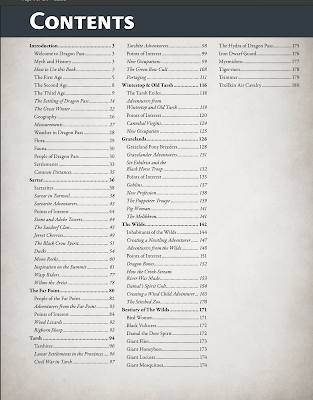IN THE DVD EXTRAS FOR PETER JACKSON'S The Fellowship of the Ring, Ian McKellen (Gandalf) talks about working with Ian Holm (Bilbo). Holm would intentionally play each take a little bit differently than before, varying his line delivery or mannerisms, so that Jackson could then look at each variant and chose which "Bilbo" was right for his film.
I mention this because it is how I think about the Jonstown Compendium. Official Chaosium publications are "canon," inasmuch as anything in Glorantha can be, but the Jonstown Compendium is the place for alternate "takes." Here creators can present different versions of Glorantha, and GMs and groups can use these variants, or the mainline canon versions, as they see fit to fashion their very own Gloranthas. Both Nick Brooke and I have presented alternate takes on the Battle of Dangerford, for example, he is his The Duel at Dangerford and myself in The Company of the Dragon. Both are very different takes, and when Chaosium gets around to theirs it will be different as well. But all are out there for gamers to pick which they like best. Likewise, I know my portrayal of the Dragonrise presented in The Company of the Dragon is not the canon version of events. My Kallyr Starbrow spends six years planning the awakening of the Brown Dragon. The canon version woke the Dragon by accident. Yet this is the joy of the Compendium. Back in June, one of my talks at Chaosium Con Australia was for aspiring Compendium writers, and this was a point that I emphasized. Don't try to do canon, do something different and give the tables out there a choice.
Let's start with what Dark Side isn't, other than canon I mean. This is not a replacement or stand-in for The Lunar Way. There is not, actually, a lot of "crunch" here (some, less than the Cult books). It also isn't a a book for beginners. What I mean by this is that if you are new to RQ and want to know what the deal is with the Lunar Empire and the Red Goddess, start with The Lunar Way. Likewise, there are no adventures here, no new monsters or NPCs.
However if you love the Lunars, and you want some deep, fascinating Lunar content, this is the book for you. I hesitate to call it either an "art book" or "coffee table book," because there is a meaty amount of content here. But it is a book that is designed to be flipped through, repeatedly, and absorbed in small bites. Dark Side is not a text so much as inspiration. Case in point, throughout the book Katrin Dirim's work accompanies passages from Stafford's Zero Wane History. Now, you could just go read most of this elsewhere, but the passages combined with Dirim's work make it a meditation exercise. No, there are not "kewl powerz" to buff your adventurer, but these passages and images will get you into the headspace of your Lunar adventurer.
The same can be said for Gidlow's "Seleric Verses," which with a trick near and dear to my heart is in-world literature that critiques current Lunar policies by comparing modern Lunar figures to heroes of the Zero Wane. No one eats up the use of invented books and scriptures more than I (and perhaps that eccentric fellow from Providence).
Notable too are Jeff Erwin's "White Moon & Blue Fox" & "Ulurda Fragments," and Margaret Gill's "The Seven Sayings of Sedenya." These are, essentially, "flavor text." Now, I have a bizarre relationship with flavor text. 90% of the time, I skip it (the White Wolf books of the 1990s were the worst offenders). Unless it is illustrating a rule or a mechanic, I can do without it in my game books. But the point I am driving at here is Dark Side is not exactly a game book as it is a setting book, a "Glorantha" book. These separate pieces are all deep dives down the Lunar rabbit hole, but so long as you go into the book knowing this, and Sedenya is your vibe, you will derive a great deal from these. In this way, Dark Side has more in common with the books in the Stafford Library than it does the main game line, and I was fine with reading (and re-reading) those over and over again.
However you also get alternative write-ups for each of the Seven Mothers cults, and this brings me full circle back to the beginning. Having the versions from The Lunar Way, and having these, is what the Compendium offers...alternatives. These alternate takes might offer the most to the most "game-oriented" reader.
A Rough Guide to Glamour and The Lunar Way are more foundational texts for the Lunar religion than Dark Side of the Moon. For example, if you wanted your Lightbringers to go visit the Lunar capital, or just wanted to know what those Lunars you are fighting believe, they are the first places to go. Dark Side is a bit more focused. It is for Lunar fans looking for more lore and myths, and in this respect Dark Side serves its audience particularly well. It is also for those of us who dig The Book of Heortling Mythology, The Glorious Re-Ascent of Yelm, and similar examples of in-world Gloranthan writings. It is a book you think about, talk about, ponder, and puzzle over. Less a meal and more a feast. And I think the Compendium needs more of this, particularly as the Cults books and Lands books come out and lay down the canon. The Compendium is for flights of fancy and alternate takes, and that Dark Side of the Moon does very well.



